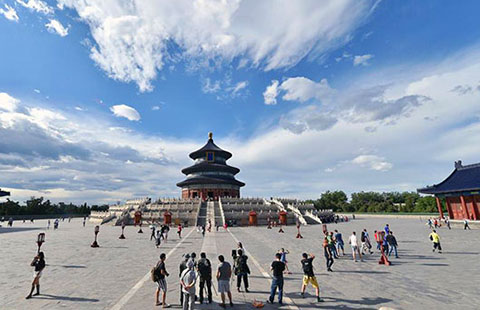Full Text: Successful Practice of Regional Ethnic Autonomy in Tibet
(Xinhua) Updated: 2015-09-06 11:12VI. Protecting and Carrying Forward the Excellent Traditional Culture
In the long course of history, the Tibetan people have created their own splendid culture that enriches and is an important component of Chinese culture. During the 50 years since its establishment, Tibet Autonomous Region has done much and made remarkable achievements towards respecting, protecting, inheriting, and carrying forward Tibet's excellent traditional culture. Tibetan culture today manifests new vitality by blending tradition and modernity.
Tibetan language learning is efficiently protected. The Constitution of the People's Republic of China and Law of the People's Republic of China on Regional Ethnic Autonomy both specify that every ethnic group has the freedom to use and develop its own language. Bilingual teaching in Tibetan and Chinese is carried out in all schools in Tibet to inherit the Tibetan language in the course of learning. At present, synchronous bilingual teaching is conducted at primary schools in agricultural and pastoral areas and certain cities and towns of the Region, and major courses are taught in Tibetan. Middle schools (including inland Tibetan middle schools) have Tibetan language courses, and other courses are taught in Chinese. Tibetan language is listed as an exam subject in college and secondary vocational school entrance exams and so figures in the final score. There are now 30,642 bilingual teachers in kindergartens, primary and middle schools, and 5,800 teachers of Tibetan language in primary and middle schools. Tibet Autonomous Region has compiled 821 textbook titles for 13 courses, 410 reference books, 56 syllabuses and curriculum standards, and 73 supplementary books.
Use of the Tibetan language is being popularized. Tibetan and Chinese are used in important meetings and their documents held in the autonomous region; Tibetan is the first choice for judicial organs in publicizing legal knowledge and law enforcement, and its use is also stressed by departments related to agriculture and technology. In 2014, Tibet People's Publishing House and Tibetan Ancient Books Publishing House published altogether 547 book titles totaling 13.025 million copies, more than 80 percent of which were in Tibetan. The Region publishes 14 Tibetan-language periodicals and 11 Tibetan-language newspapers. At present, Tibet People's Broadcasting Station broadcasts 42 Tibetan-language programs (including Kangba language) each day, including 21 hours and 15 minutes of news in Tibetan language and 18 hours of Kangba programs. Tibetan TV airs 24 hours of Tibetan-language programs. Wide use of the Tibetan language in postal services, communications, transport, and finance also promotes the autonomous region's rapid social and economic development.
Excellent traditional culture is protected and inherited. The state has founded education centers and research institutes, such as Tibet University, Xizang Minzu University, Tibetan Traditional Medical College, China Tibetology Research Center, Tibetan Academy of Social Sciences, and Tibetan Institute of Astronomy, all of which cover extensive studies. Over the decades, Tibet has organized large-scale and systematic campaigns to restore its traditional culture, having collected more than 10,000 pieces of music, songs and folk art forms, and more than 30 million words of written texts. It has also recorded copious audios and videos, taken about 10,000 photos, and published more than 1,000 papers on Tibetan ethnic and traditional culture and 10 volumes on Tibetan arts, such as Chinese Drama - Tibetan Volume, Collection of Folk Dances of Chinese Ethnic Groups - Tibetan Volume, and Collection of Chinese Ethnic and Folk Music - Tibetan Volume. It has moreover published more than 30 treatises on Tibetan culture, having restored, reorganized and published 261 Tibetan ancient books. All these efforts help to save, protect and revitalize endangered ethnic and folk culture. Since 2005, when the work of surveying and protecting Tibetan intangible cultural heritage was officially launched, the central government and Tibet have channeled about 200 million yuan into efforts to preserve items of important intangible heritage, such as Tibetan opera, Gesar, traditional singing and dancing, and craftsmanship, thus forming a four-level intangible heritage protection category at the state, autonomous region, prefecture, and county level. Currently, there are more than 1,000 intangible heritage items covering 10 categories as defined on the intangible heritage list. Among them, Tibetan opera and Gesar have been chosen as Masterpieces of UNESCO Intangible Heritage of Humanity, and 89 are on the state level intangible heritage list. There are four production pilots under state level protection and 323 items under the autonomous regional protection, 113 sites for the teaching and learning of intangible heritage, and 68 state level inheritors and 350 inheritors at the autonomous region level. The Region is home to 158 precious ancient books and four state key protection units, four Hometowns of Chinese Folk Art, and 65 Hometowns of Folk Art in Tibet Autonomous Region. Traditional festivals such as the Shoton Festival and Yarlung Cultural Festival have been resumed and innovated, so becoming local cultural brands.
Cultural relics are under effective protection. Over the past 50 years, the state has constantly renewed its efforts to protect Tibetan cultural relics, particularly with regard to the maintenance and protection of cultural relics under the jurisdiction of Tibet Autonomous Region, restoring and saving them in a timely manner. The 46 key cultural relics renovation and protection projects listed in the 12th Five-year Plan at a cost of more than one billion yuan is proceeding smoothly. Relevant local regulations have been issued, such as the Regulations of Tibet Autonomous Region on the Protection of Cultural Relics, and the Measures of Tibet Autonomous Region for the Protection and Management of the Potala Palace. Excavation of important historical and revolutionary cultural relics has been strengthened, and the third survey of immovable cultural relics across the Region is complete, which recorded 241 important historical sites and renowned architectures and 4,277 cultural relics sites of all kinds. The first survey of movable cultural relics has also been launched. According to statistics, there are millions of such relics across the Region. Security staff has been assigned to guard cultural relics in the wild, so further strengthening the security of cultural relics across the Region. Phased progress has been made in survey, protection and research of Pattra-leaf Scriptures, and The Tibet Autonomous Region Pattra-leaf Scripture Catalogue and Photocopy of Tibet Autonomous Region Pattra-leaf Scriptures have been published. Currently there is one world cultural heritage site spread over three places, 55 cultural relics protection units at state level, 391 at autonomous region level, 978 at city and county level, and three state historical and cultural cities.
- Delegation salutes Tibet anniversary
- Officials are told to act as anti-graft watchdogs
- Great Wall safeguarded in united action
- Vice minister pledges more efforts to improve air quality
- Beijing’s efforts to control air pollution start to pay off
- China's military committed to reform
- Netizens rip singer over baby photos
- Central govt's growing support for Tibet
- Monument to be built on Tianjin blast site
- China and Russia seal raft of energy deals







